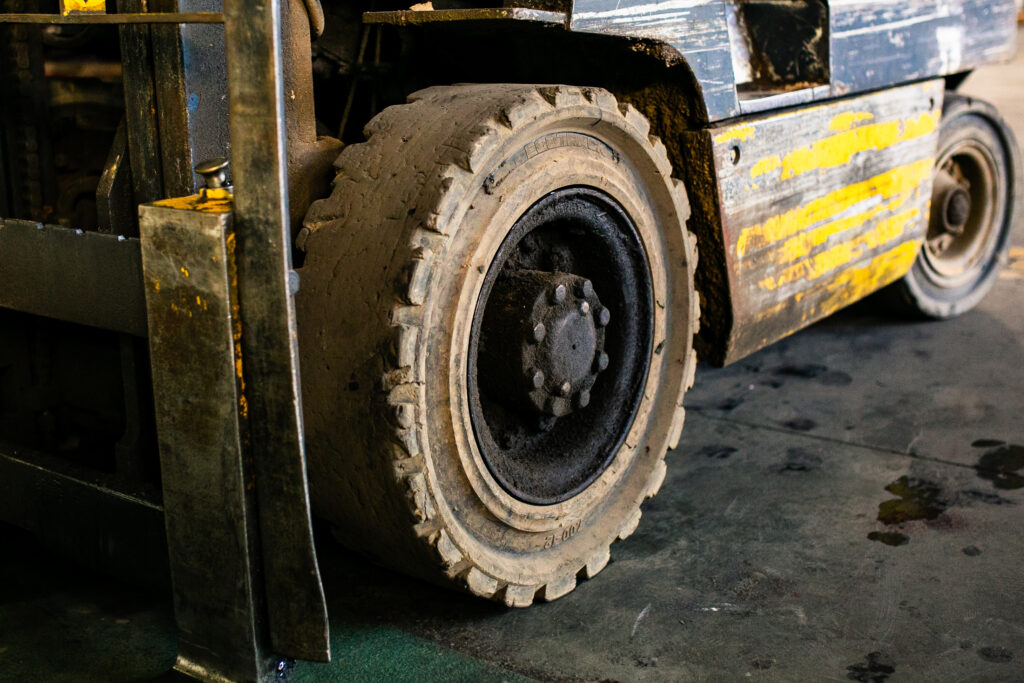Signs You Need to Replace Forklift Tires

When to Replace Your Forklift Tires
You depend on your forklift to move your products and complete daily operations in your facility, and your forklift depends on its tires. Worn out forklift tires can cause instability for the machine and for whatever it is moving, stopping or accelerating can become more difficult, and potentially dangerous situations can result in your warehouse or work area.
To help you handle forklift tire maintenance effectively and identify tires that need to be replaced, we put together some key tips and best practices.
Forklift tires bear the bulk of your load
Forklifts don’t have traditional suspension systems like many other vehicles. What that means is the entire weight of the machine rests on its tires. For example, the front tires on a 5,000 lb capacity forklift actually have to support up to over 11,000 lb. All that weight means that your solid cushion and pneumatic forklift tires will typically wear out faster than you might expect.
Danger signs to watch for
There are some clear indicators that it’s time to replace your forklift tires:
-
Wear line – Most forklifts will have what is called a wear line. Once the wear on your tires reaches that line, it’s time to replace them.
-
33% rule – For cushion tires specifically, you don’t want them to wear down to less than two thirds of their original rubber height.
-
Tearing and chunking – If pieces of your forklift tires are starting to fall or tear off, then is a sure sign that it’s time to replace them.
-
Flat spots – Your forklift tires should be round. If they are flat in any areas, then it’s time to think about new ones.
Forklift tire maintenance
Once you start to notice the replacement signs above, it’s time to take the right steps to ensure your forklift tires last as long as possible before replacing. Follow these forklift tire maintenance tips to increase their lifespan:
-
Regularly inspect tire pressure – We recommend checking pneumatic forklift tire pressure before every shift or at least every day. Overinflated tires can lead to blowouts and accidents, while underinflated tires can lead to increased wear, punctures, and wheel damage.
-
Check the tread – For environments where a high level of tread is required, it’s crucial to regularly look at the tread to ensure continued integrity. Use a tread depth gauge to determine how much tread is left and look closely for punctures and signs of impact.
-
Lubricate regularly – Properly lubricating the power and braking systems will reduce tire drag and sudden stops, which can lead to increased wear and tear.
-
Avoid overloading – Driving an overweight forklift can lead to tire chipping, blowouts, and base separation.
-
Center your load – By centering the forklift load, its weight will be spread more evenly over each of the tires.
-
Don’t let loads sit – If you leave loads standing overnight or for an extended period of time, it can lead to flat spots forming on your forklift tires.
-
Keep aisles in good condition – Floors with debris, cracks, and breaks create a bumpy ride, which leads to faster wear rates, and they can cut or puncture a forklift tire.
Forklift tire inspections are key
Proper forklift tire maintenance ultimately comes down to being aware of their condition. Daily checks are crucial to see if they need to be replaced or if any tires are experiencing abnormal or accelerated wear.
If you have any questions about forklift tire maintenance, when to replace them, or which replacements to buy, contact our team today!
